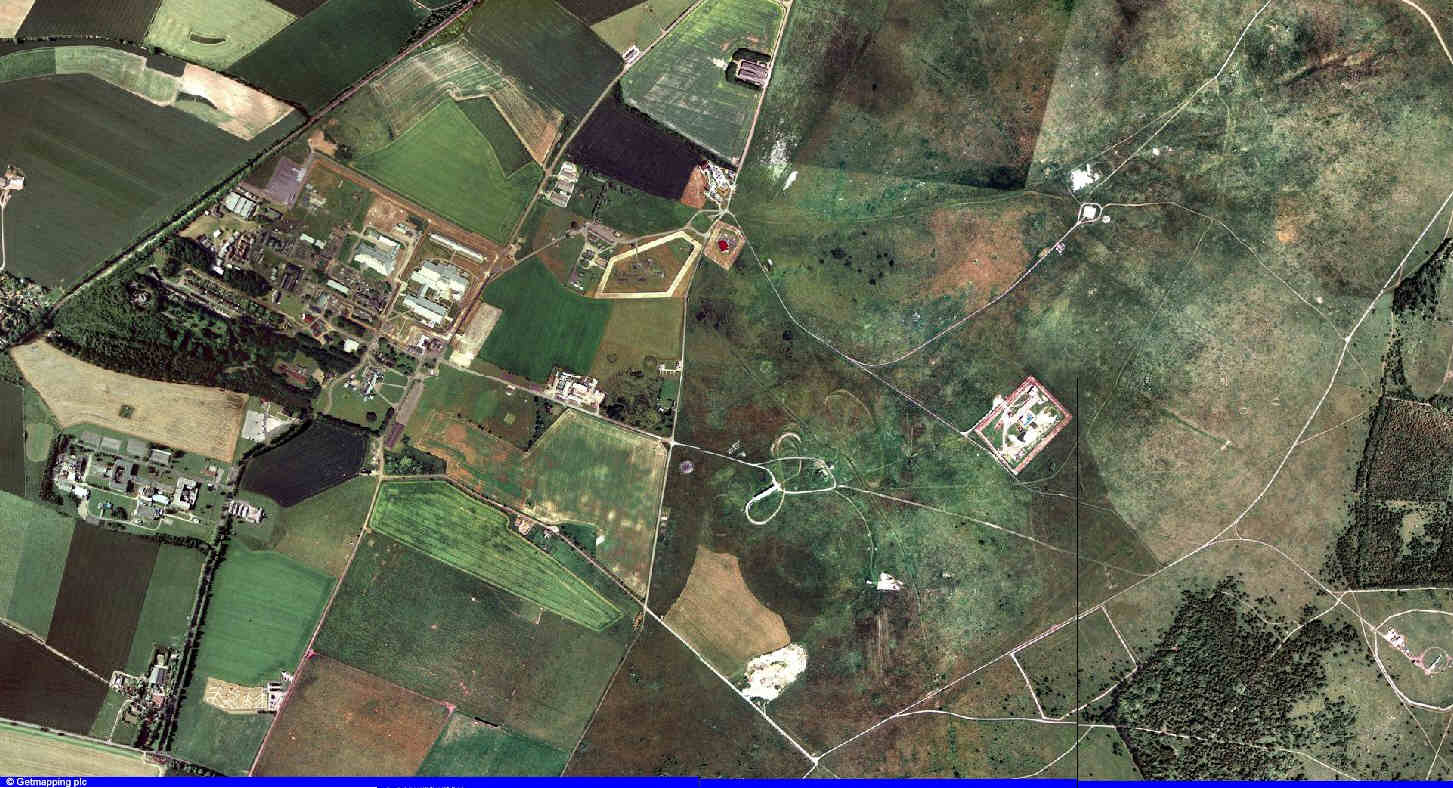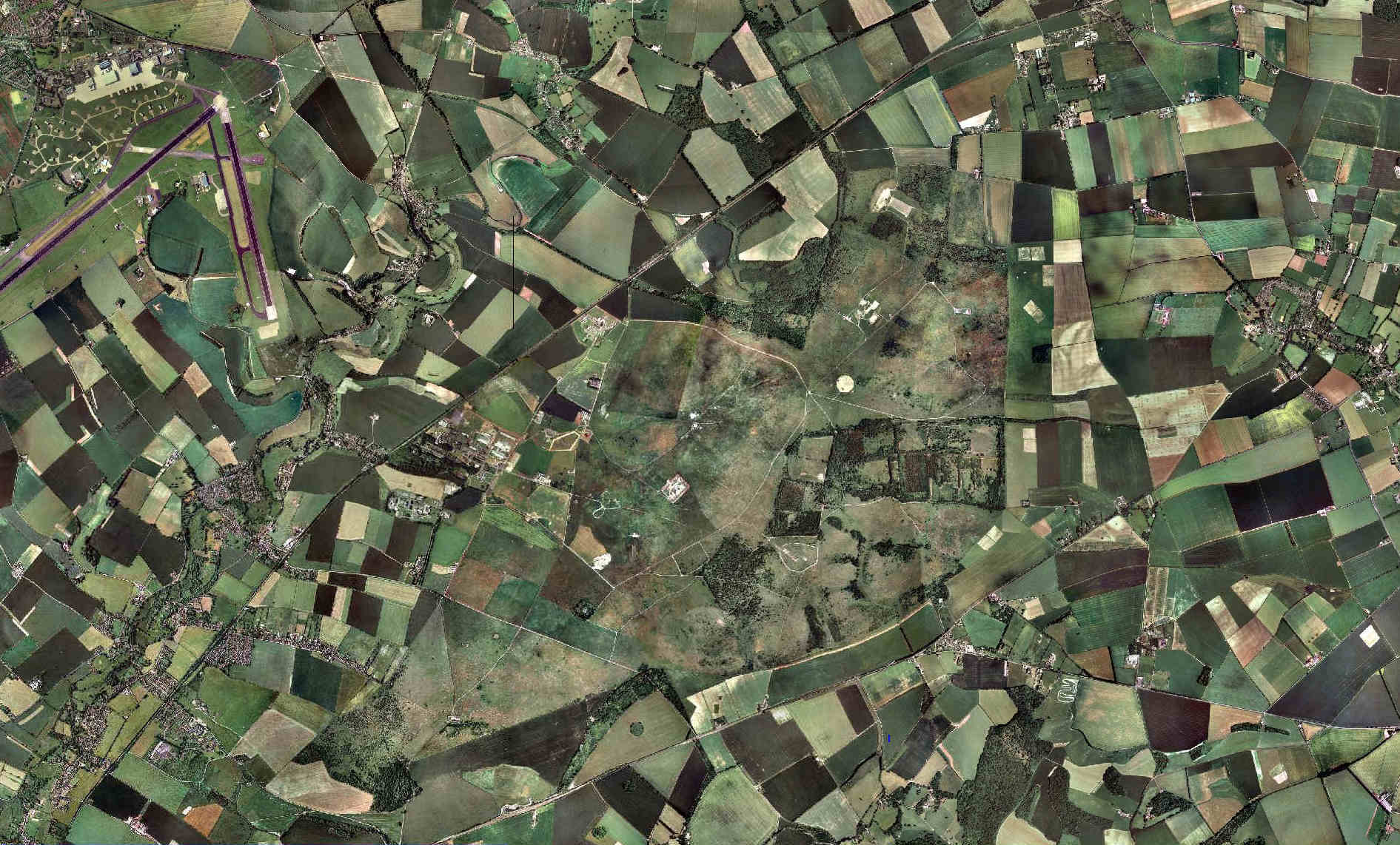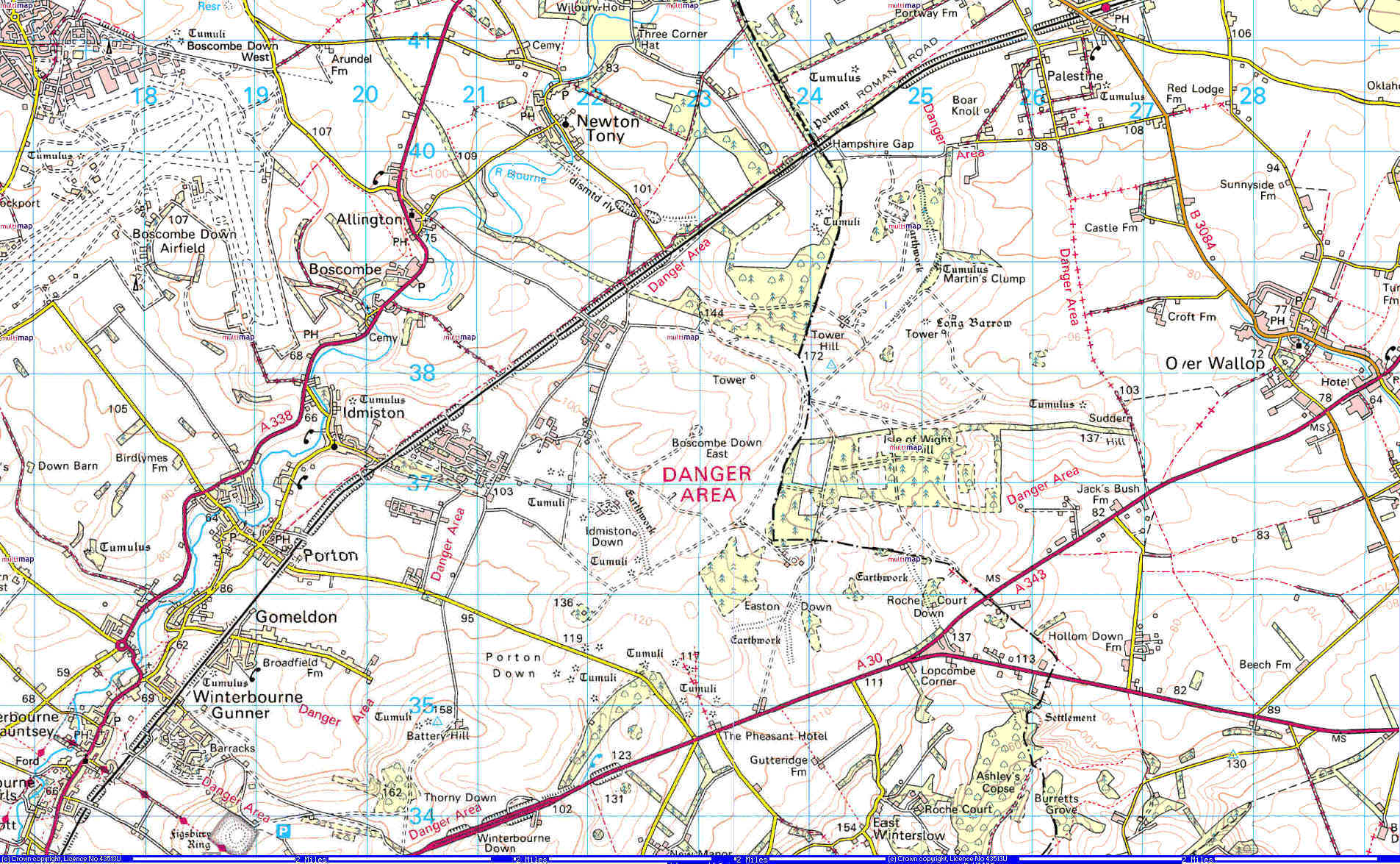Eyeballing
the
Defence Science and Technology Laboratory (DSTL)
Porton Down

30 July 2003. One of the Eyeball
series.
Source of photos and maps:
http://www.multimap.com
Defence Science and Technology Laboratory (DSTL): http://www.dstl.gov.uk
DSTL, Porton Down, is one of seven laboratories: http://www.dstl.gov.uk/about_us/locations.htm#
http://www.mod.uk/issues/portondownvolunteers/history.htm
Porton Down Volunteers: A Brief History Of Porton DownIt is eighty-five years since the “experimental ground” was set up at Porton Down to provide a proper scientific basis for the British use of chemical warfare, in response to the earlier German use of this means of war in 1915. Work at Porton started in March 1916. At the time, only a few cottages and farm buildings were scattered on the Downs at Porton and Idmiston.
By 1918 the original two huts had become a large hutted camp with 50 officers and 1,100 other ranks. Studies in the Great War mainly concerned the dissemination of chlorine and phosgene and, later, mustard gas. By May 1917 the focus for anti-gas defence and respirator development had moved from London to Porton Down.
After the Armistice, staff at Porton Down were reduced to a skeleton level. In 1919 the War Office set up the Holland Committee to consider the future of chemical warfare and defence. By 1920, the Cabinet agreed to the Committee’s recommendation that work should continue at Porton Down and from that date a slow permanent building programme began coupled with the gradual recruitment of civilian scientists. By 1922, there were 380 servicemen, 23 scientific and technical civil servants and 25 “civilian subordinates”. By 1925 the civilian staff had doubled.
Since its establishment in 1916 Porton Down has undergone several changes of title and responsibility:
Royal Engineers Experimental Station
1916-1929 Chemical Warfare Experimental Station (CWES)
1929-1930 Chemical Defence Experimental Station (CDES)
1930-1948 Chemical Defence Experimental Establishment (CDEE)
1948-1970 Chemical Defence Establishment (CDE)
1970-1991 Chemical and Biological Defence Establishment (CBDE)
1991-1995 Chemical and Biological Defence (CBD) Sector of the
Defence Evaluation and Research Agency (DERA)1995-2001 Defence Science and Technology Laboratory (DSTL),
Porton Down2001- Between 1920 and the end of the Second World War, the main emphasis was on mustard gas and the multiplicity of problems attending both its use in war and the defence of the Services from this potent agent.
By 1926 the chemical defence aspects of Air Raid Precautions (ARP) for the civilian population was added to the Station’s responsibilities. By 1938, the international situation was such that offensive chemical warfare research and development and the production of war reserve stocks of chemical warfare agents by the chemical industry was authorised by the Cabinet. Britain had ratified the 1925 Geneva Protocol in 1930 with reservations which permitted the use of chemical warfare agents only in retaliation. The principle remained extant until 1955-1956, when Britain abandoned a programme to modernise its retaliatory capability. Since then, the residual stocks of agents were destroyed and work at Porton Down has been solely in assessment of the hazards of chemical warfare and in defensive requirements.
Chemical warfare was not used by any nation during the Second World War but as Allied armies penetrated Germany, operational stockpiles of munitions and weapons were discovered which contained new chemical warfare agents; the highly toxic organophosphorous nerve agents, unknown to Britain and the Allies. The late 1940s and early 1950s saw research and development at Porton Down aimed at providing Britain with the means to arm itself with a modern nerve agent based capability and to develop specific means of defence against these agents. In the end these aims came to nothing on the offensive side because of the decision to abandon any sort of British chemical warfare capability. On the defensive side there were years of difficult work to develop the means of prophylaxis, therapy, rapid detection and identification, decontamination and more effective protection of the body against nerve agents, capable of exerting effects through the skin, the eyes and respiratory tract.
In the 1950s the Chemical Defence Experimental Establishment became involved with the development of CS, a riot control agent, and took an increasing role in trauma and wound ballistics work. Both these facets of Porton Down’s work had become more important because of the situation in Northern Ireland. In 1970 the Chemical Defence Establishment became the title of the senior establishment at Porton Down and remained for the next 21 years. Preoccupation with defence against the nerve agents continued but in the 1970s and 1980s the Establishment was also concerned with studying reported chemical warfare by Iraq against Iran and against its own Kurdish population. Following the Iraqi invasion of Kuwait in August 1990, the problems increased, culminating in active operational support of British Forces in the Gulf region. After the Gulf cease-fire the establishment continued to provide technical support for the United Nations Special Commission set-up to oversee the destruction of the Iraqi capability to use nuclear, biological and chemical weapons. This continued until 1999 when Iraq withdrew co-operation from the Commission.
Throughout the last few decades the Establishment has also provided technical support for the implementation of the Chemical Weapons Convention, whose signatories have agreed to renounce and destroy all chemical warfare capabilities and to continue their interest solely in defensive research and development. In the twenty-first century the proliferation of chemical and biological weapons is of considerable concern, as is that of terrorist use. From 1940 Porton was also the centre of British interest in biological warfare and defence against it. Following the start of the Second World War a highly secret and independent group was set up at Porton Down by the War Cabinet, with a mandate to investigate the reality of biological warfare by experiment and, if established, to develop a means of retaliation in kind in the event of the use of biological warfare against Britain and its Allies. The group, known as Biology Department, Porton, initially consisted of less than a dozen medics, scientists and technicians. The staff grew quickly but never exceeded about 50 people of diverse origins, including several American bacteriologists commissioned as Army and Navy officers. By 1946, the name of the wartime group had become the Microbiological Research Department. In 1951 the Department had moved to a vast building adjacent to what had, by then, become the Chemical Defence Experimental Establishment. In 1957 the Department became the Microbiological Research Establishment.
By 1955-1956 research at both Porton Down Establishments had become solely defensive and Britain abandoned moves to establish any offensive capabilities. Work continued on biological defence and an increasing amount of civil microbiological work. By the 1970s it was decided that a reduced programme of biological defence work should be started by a small team transformed from the Establishment to the Chemical Defence Establishment and that the Microbiological Research Establishment should be placed under the aegis of a civil authority. The Establishment closed as a Ministry of Defence facility on 31 March 1979 and re-opened the next day as the Centre for Applied Microbiology and Research (CAMR) within the Public Health Laboratory Service (PHLS). In April 1994, CAMR moved from PHLS centre to the Microbiological Research Authority (MRA), reporting to the Department of Health and still continuing the programme in civil microbiological research started in 1979. Thus, by 1991 the Chemical Defence Establishment became the Chemical and Biological Defence Establishment and was one of the six new Defence Support Agencies. In 1995, the Establishment became part of the Defence Evaluation and Research Agency (DERA), an executive agency of MOD evolved in 1994 from proposals of the “Front Line First” Defence Cost Studies. In 2001, DERA split into two organisations: QinetiQ, a private company, and DSTL (Defence Science and Technology Laboratory), which remains an agency of MOD. Porton Down is now known as DSTL, Porton Down.
NB The above text is taken from the article “Porton Down: a brief history” by G B Carter, Porton Down’s official historian. A more in-depth account can be found in Mr Carter’s book Chemical and Biological at Porton Down 1916-2000 (The Stationery Office, 2000).
|
 |
 |
 |
 |